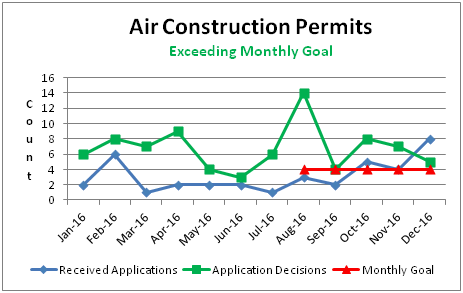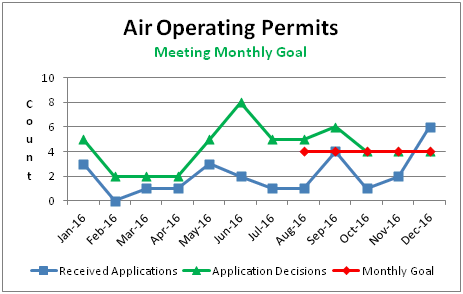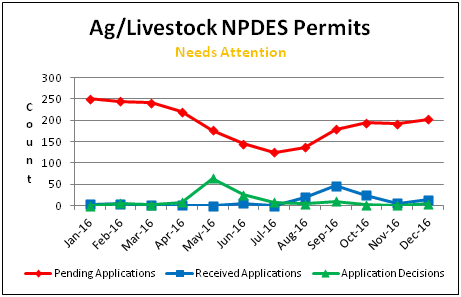December 2016 Metrics Report







Nitrate in Groundwater

Many areas of the state are susceptible to nitrate contamination due to shallow depth to groundwater and sandy soils. Nitrate in groundwater results from application of fertilizer and manure to cropland. Other sources include under-performing septic systems and fertilizer spills. Natural Resources Districts (NRDs) require a variety of management practices in areas with elevated nitrate. On-going nitrate control efforts, e.g. restricting fall fertilization, may take decades before results can be measured.
The 23 NRDs and several other agencies take 4000-5000 groundwater samples annually, testing for nitrate and other contaminants. Data are compiled in a coordinated effort by NDEQ, the Nebraska Department of Agriculture, and the University of Nebraska-Lincoln. The Department of Natural Resources hosts the Quality-Assessed Agrichemical Contaminant Database for Nebraska Groundwater. http://nednr.nebraska.gov/Clearinghouse
Public Water Supplies Impacted by Nitrate

This map shows community public drinking water systems with nitrate control requirements. Requirements often involve Administrative Orders mandating that communities solve their nitrate problem and, in the meantime, provide an alternate source of water to pregnant women and infants. The map also shows systems currently treating their water for nitrate (reverse osmosis and ion exchange are the most common methods) and the systems which are near the drinking water standard and monitoring the groundwater quarterly for nitrate.
The Nebraska Wellhead Protection Network (Network) is made up of a number of agencies and organizations involved in some aspect of groundwater protection. The Network began meeting in 2001 to discuss their work and identify community needs in addressing nitrate contamination. Together they support communities developing and implementing Wellhead Protection Programs which serve to protect drinking water and groundwater. The Groundwater Foundation, through a grant from NDEQ, serves as facilitator for the Network.
Emerging Issues/Risks: NDEQ is, or soon will be, addressing significant permitting actions involving the following:
Lincoln Premium Poultry – Fremont: The facility will process 350,000 chickens per day and is estimated to result in the addition of 100 poultry growing facilities. An Air Quality Construction Permit application was received December 23rd. Water Quality stormwater permits have already been issued.
Raven Northbrook – Omaha: This will be the state’s largest data center. The notification of intent to approve the project has been public noticed – Air Quality staff accomplished the review of this major source in 111 days.
NioCorp – Elk Creek. The proposed rare earth metals mine has proposed an aggressive permitting schedule. NDEQ continues to meet with NioCorp officials and other agencies, including environmental permitting staff from KS, MO and IA. NDEQ has also been coordinating with EPA Region VII, who has expressed keen interest in NioCorp.
Accomplishments: Under the NDEQ Voluntary Clean-up Program (VCP) a “No Further Action” letter was issued to the City of Lincoln for a large portion of Lincoln’s Haymarket District. This was the culmination of a six-year NDEQ effort in the review and oversight of the clean-up of the former Burlington Northern and Santa Fe rail yard. This clean-up facilitated the mixed-use redevelopment of the former rail yard and hastened the building of Pinnacle Bank Arena and surrounding restaurants, hotels, parking garages, apartments, offices and retail businesses. Over the course of the effort NDEQ and the City of Lincoln developed a strong partnership in addressing the environmental cleanup challenges posed by the site. The partnership resulted in the enrollment of additional West Haymarket projects south of O Street into the VCP program. Additionally, several potential Brownfields projects in the South Haymarket area have been identified and are candidates for the VCP.
Misc. Items of Note: In accordance with federal Superfund requirements, costs associated with National Priority List (NPL) sites where no responsible party has been identified are paid for by EPA for the first 10-years of the remediation. The 10th Street site in Columbus has reached the 10-year threshold. Costs from this point forward for continued remediation will be borne by the state. As reported in the July 2016 Monthly Metrics report, there are currently an additional three sites that will fall into this category over the next five years.